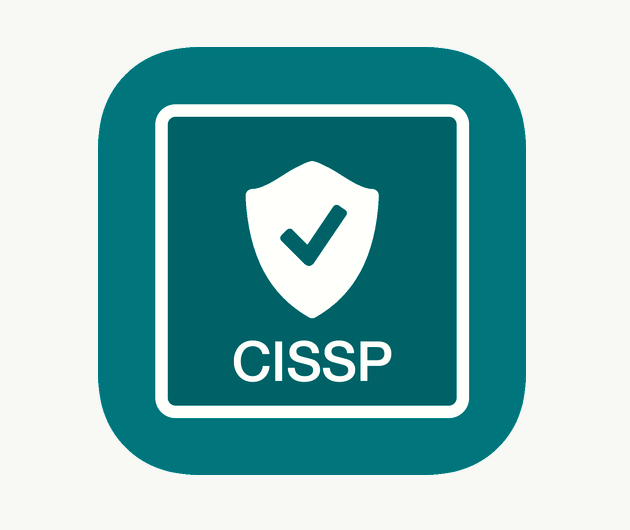CISSP - Question Bank 08
Test your knowledge of CISSP with these multiple choice questions. Each Question Bank includes 20 practice questions that have been designed to measure your knowledge of key ideas.
A key factor to keep in mind is that guessing is better than not answering a question.
Every single question on the CISSP exam is a four-option multiple choice question with a single correct answer. Some are straightforward, such as asking you to select a definition. Some are a bit more involved, such as asking you to select the appropriate concept or best practice. And some questions present you with a scenario or situation and ask you to select the best response.
StartQ1. What is the size of the Master Boot Record on a system installed with a typical configuration?
A. 256 bytes
B. 512 bytes
C. 1,024 bytes
D. 2,048 bytes
Q2. How many steps take place in the standard TCP/IP handshaking process?
A. One
B. Two
C. Three
D. Four
Q3. Which one of the following types of attacks relies upon the difference between the timing of two events?
A. Smurf
B. TOCTTOU
C. Land
D. Fraggle
Q4. What propagation technique does the Good Times virus use to spread infection?
A. File infection
B. Boot sector infection
C. Macro infection
D. None of the above
Q5. What advanced virus technique modifies the malicious code of a virus on each system it infects?
A. Polymorphism
B. Stealth
C. Encryption
D. Multipartitism
Q6. Which one of the following files might be modified or created by a companion virus?
A. COMMAND.EXE
B. CONFIG.SYS
C. AUTOEXEC.BAT
D. WIN32.DLL
Q7. What is the best defensive action that system administrators can take against the threat posed by brand new malicious code objects that exploit known software vulnerabilities?
A. Update antivirus definitions monthly
B. Install anti-worm filters on the proxy server
C. Apply security patches as they are released
D. Prohibit Internet use on the corporate network
Q8. Which one of the following passwords is least likely to be compromised during a dictionary attack?
A. mike
B. elppa
C. dayorange
D. dlayna
Q9. What file is instrumental in preventing dictionary attacks against Unix systems?
A. /etc/passwd
B. /etc/shadow
C. /etc/security
D. /etc/pwlog
Q10. Which one of the following tools can be used to launch a distributed denial of service attack against a system or network?
A. Satan
B. Saint
C. Trinoo
D. Nmap
Q11. Which one of the following network attacks takes advantages of weaknesses in the fragment reassembly functionality of the TCP/IP protocol stack?
A. Teardrop
B. Smurf
C. Ping of death
D. SYN flood
Q12. What type of reconnaissance attack provides hackers with useful information about the services running on a system?
A. Session hijacking
B. Port scan
C. Dumpster diving
D. IP sweep
Q13. A hacker located at IP address 12.8.0.1 wants to launch a Smurf attack on a victim machine located at IP address 129.74.15.12 utilizing a third-party network located at 141.190.0.0/16. What would be the source IP address on the single packet the hacker transmits?
A. 12.8.0.1
B. 129.74.15.12
C. 141.190.0.0
D. 141.190.255.255
Q14. What type of virus utilizes more than one propagation technique to maximize the number of penetrated systems?
A. Stealth virus
B. Companion virus
C. Polymorphic virus
D. Multipartite virus
Q15. What is the minimum size a packet can be to be used in a ping of death attack?
A. 2,049 bytes
B. 16,385 bytes
C. 32,769 bytes
D. 65,537 bytes
Q16. Jim recently downloaded an application from a website that ran within his browser and caused his system to crash by consuming all available resources. Of what type of malicious code was Jim most likely the victim of?
A. Virus
B. Worm
C. Trojan horse
D. Hostile applet
Q17. Alan is the security administrator for a public network. In an attempt to detect hacking attempts, he installed a program on his production servers that imitates a well-known operating system vulnerability and reports exploitation attempts to the administrator. What is this type of technique called?
A. Honey pot
B. Pseudo-flaw
C. Firewall
D. Bear trap
Q18. What technology does the Java language use to minimize the threat posed by applets?
A. Confidentiality
B. Encryption
C. Stealth
D. Sandbox
Q19. Renee is the security administrator for a research network. She's attempting to convince her boss that they should disable two unused services-chargen and echo. What attack is the network more vulnerable to with these services running?
A. Smurf
B. Land
C. Fraggle
D. Ping of death
Q20. Which one of the following attacks uses a TCP packet with the SYN flag set and identical source/ destination IP addresses and ports?
A. Smurf
B. Land
C. Fraggle
D. Ping of death
- Question Bank 00
- Question Bank 01
- Question Bank 02
- Question Bank 03
- Question Bank 04
- Question Bank 05
- Question Bank 06
- Question Bank 07
- Question Bank 08
- Question Bank 09
- Question Bank 10
- Question Bank 11
- Question Bank 12
- Question Bank 13
- Question Bank 14
- Question Bank 15
- Question Bank 16
- Question Bank 17
- Question Bank 18
- Question Bank 19


